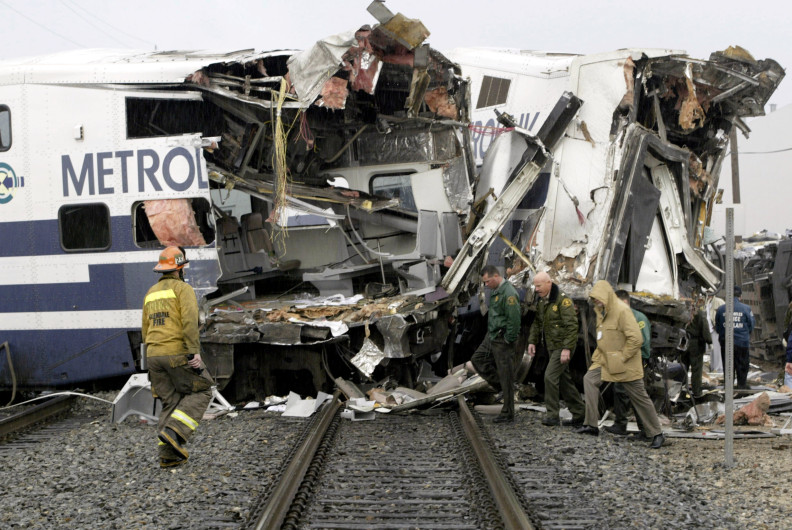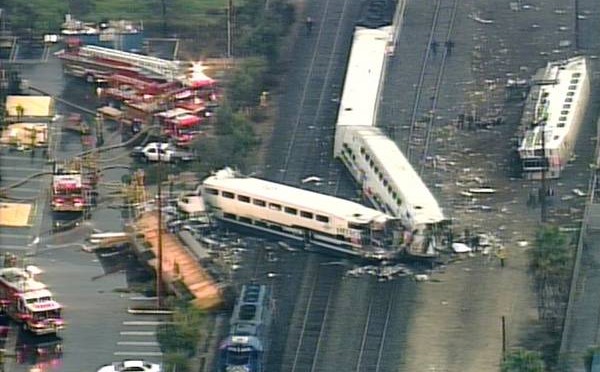Ken Piper
Commuter trains are not as safe as most of us believe. We tend to believe that because trains are big and heavy, they are safe. But this is not necessarily true. Train accidents don’t usually get as much attention as they deserve outside of the local commuting area or after the hubbub over a recent accident subsides.
What makes commuter trains unsafe?
Many commuter rail lines use push-pull train configurations. This is so the engineers can just walk to the opposite end of a train and run it the other direction from a control room built into a passenger car. It gives them a faster turnaround, but is a dangerous practice.
Rail fatalities usually occur in derailments after a collision with a vehicle on a grade crossing, a collision with another train, or from excessive speed around a curve. A technology called Positive Train Control (PTC) can help with the excessive speed problem and maybe even reduce collisions with other trains.
PTC is not going to help with problems at grade crossings. However, there is an easy way to make the inevitable collisions safer for the rail passengers.
In “Why are the trains still running backwards“ I showed why to be safe requires keeping the trains on the track, or at least avoiding a catastrophic derailment.
Why are commuter trains still running backwards? Share on X
What we need – NOW – to reduce the severity of derailments and save lives.
Keep the trains on the track or, at least keep them from derailing catastrophically. To do this the locomotive must be in the front of the train.
Safety advantages of leading locomotives:
1. The heavy leading locomotive will be much less likely to derail in a collision. A one-inch flange on the wheels is ultimately what keeps the trains on the tracks. This is not much for a train going 70 miles per hour. Locomotives weigh about twice as much as a passenger car and are not easily dislodged from the rails when hitting an object on the tracks.
2. A leading locomotive will be a buffer between the passengers and whatever they may run into. Locomotives are not only heavier, but also sturdier than passenger cars, so even the engineers are safer in a lead locomotive than they would be in the control room at the front end of a modified passenger car.
3. If a leading locomotive does derail, the cars will tend to follow it, rather than be pushed off the tracks by it. Sometimes they don’t even tip over. If there is an embankment, they may fall over on their sides, but will usually not end in a pileup. Few fatalities occur in these cases.
4. If the locomotive is pushing the passenger cars at a high speed, it will push them into a pileup as soon as the lead car leaves the tracks. There are two reasons for this:
First, because a locomotive is about twice the weight of a passenger car, its momentum will cause it to continue to push the other cars after they have hit an obstacle.
Second, pushing is not a stable situation in the first place. Have you ever seen a big-rig back up more than a few feet with more than one trailer? They don’t do it! Instead, they drop off the back trailer and do one at a time. If a locomotive is leading, the cars will follow in line; if it is following, they will not stay in line once off the tracks.
5. Don’t put a second locomotive at the rear! Occasionally this has been done to placate concerned citizens for a while after a deadly collision. However, this is not a good idea. In a collision that does cause a derailment of the lead locomotive, the heavy locomotive at the rear will crush the cars against the derailed lead locomotive and also cause a catastrophic pileup.
To reduce the severity of commuter train collisions, the solution is clear and simple; put the locomotive in front – and only there.
To reduce the severity of commuter train collisions, the solution is clear and simple; put the locomotive in front – and only there. Share on X
6. And one more neglected, but obvious thing – install seat belts on commuter trains!
What else can be done?
Derailment of trains traveling at excessive speed around a curve is another big problem, because trains have a high center-of-gravity and a narrow wheelbase (only 4 feet 8 1/2 inches), so they can tip over more easily than automobiles, and even than big-rig trucks.
For trains that are traveling at excessive speed on curves, PTC can help, and it has already been installed on many rail lines.
Eliminate double-deck cars and increase the rail spacing (wider wheelbase).
Why have commuter rail lines refused to do this?
They may tell you that in order to reverse the train they will need long wyes (a “Y” shaped turnaround), long enough to accommodate the entire train, and land is not easily or cheaply available. This is not true!
How else can they turn commuter trains around?
All that is needed is to use a double-ended locomotive and run it around to the other end of the train at a rail siding that is near the turnaround location.
Double-ended electric locomotives are used in the eastern U.S. Double-ended diesel-electric locomotives are common in Europe, and some of those are even manufactured in the U.S. In the interim, paired locomotives (or a locomotive and cab car – without passengers) can be used.
Sidings are already common in areas served by commuter trains. If necessary, sidings can be added within the existing railroad right-of-way – no land purchase necessary.
There is still some extra cost, because a trained person must do the uncoupling and recoupling that is needed. So, you need at least 2 people per train that are technically proficient – the engineer and a person to do the uncoupling. But isn’t it worth the cost for passenger safety?
What can you do now?
Authorities do not want to admit this is a problem. When deadly accidents occur, the authorities quickly turn the attention to the cause of the accident, rather than the severity.
When deadly accidents occur on commuter and other passenger trains, authorities quickly turn the attention to the cause of the accident, rather than the severity. Share on X
Why have they refused to admit the safety problems with commuter trains? The answer is money.
Commuter rail agencies don’t put commuter safety first. They put money first. This seems odd because they are generally public non-profits, and subsidized by public money.
Newspapers and television news don’t care much either. They care about selling newspapers and advertisements. I know because I wrote to many newspapers in areas where trains are run push-pull. They will not publish my letters; they only care if somebody died recently, so that it makes news.
But you, as a commuter, should care a lot!
And you need to make it known what they need to do to make your commute safer.
I want you to care enough to share this article with others you know who ride commuter trains or care about rail safety. Contact the National Transportation Safety Board and Federal Railroad Administration and demand action. Write to, or share this article with your elected representatives. I can’t do this; I have tried. They will only take calls from, or read letters from, their own constituents.
Finally, let me know in the comments section, or by emailing me, any further ideas you have that I have not covered here. Thanks for caring.
Featured image from Daily News article: Photos: A look back at the 2005 Metrolink train crash in Glendale.


